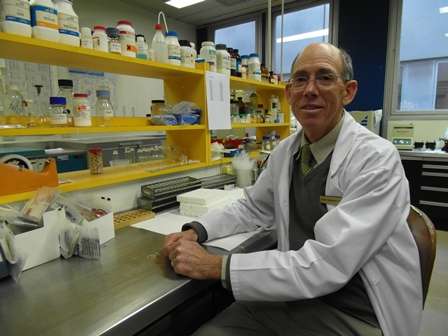At the London Olympics in 2012, South African swimmer Cameron van den Burgh dedicated his world record-breaking win in the 100m breast stroke to one of his biggest rivals and closest friends, Alexander Dale Oen.
Oen, from Norway, had been found dead in his hotel bathroom a few weeks before the competition, after suffering a heart attack. He was 26.
Doctors later found out he had died as a result of having high cholesterol, a condition he inherited from his father.
"Unfortunately, since he was a super-fit athlete, Oen had never tested his cholesterol, and there were no other symptoms," says Professor Derick Raal.
Raal heads the Division of Endocrinology and Metabolism at the Charlotte Maxeke Johannesburg Academic Hospital, and runs a research unit, the Carbohydrate and Lipid Metabolism Research Unit in the Wits School of Clinical Medicine. His own research focusses on familial hypercholesterolemia (FH), or inherited cholesterol.
FH differs from the high cholesterol levels that might be observed in individuals who suffer from diseases associated with a poor diet and a lack of exercise. FH is genetic, affecting younger people regardless of how healthy their diet or active their lifestyle.
"South Africa has one of the highest prevalence of FH, particularly in the Jewish, Afrikaner and Indian populations," says Raal.
But South Africa is also one of the worst affected when it comes to the so-called triple burden of disease: infectious diseases that affect children in particular, the scourge of HIV, and chronic diseases of lifestyle as a rising middle class becomes rapidly westernised.
"I see patients five days a week, treating some of the most common diseases in our society."
Raal says his Division services two big diabetic clinics per week, a thyroid clinic, a bone clinic for the elderly and a lipid-cholesterol clinic, among others.
His excessively heavy clinical load leaves little room for research, but he makes as much time as possible available to currently mentor his eight MMed and two PhD students, and to conduct clinical trials with new cholesterol drugs.
"If you find a drug works in a FH patient, you can be almost sure it will work in non-FH patients with high cholesterol," says Raal.
He adds that he is happy to test the drugs as long as pharmaceutical companies provide the drug to all study participants once they confirm that it works. "Our patients thus get what they call 'compassionate use' for many years, until the drug becomes available in our country."
In a single week in October 2014, Raal had two papers published in one of the world's leading medical journals, The Lancet.
The first paper was on RUTHERFORD-2, a large, worldwide multinational study of the use of the PCSK9-inhibitor, evolocumab, in over 300 patients with heterozygous familial hypercholesterolaemia (HeFH) who had elevated LDL-cholesterol levels despite statin with or without ezetimibe therapy.
HeFH is one of the most common inherited disorders, affecting between 1:250 to 1:300 persons worldwide. According to Raal, statins are remarkable drugs but, even at high dose, only lower LDL-cholesterol by 50-55%. Therefore, even in combination with ezetimibe, many patients with HeFH do not get their LDL-cholesterol levels to target.
The study showed that evolocumab administered either 140 mg biweekly or 420 mg monthly as a subcutaneous injection, much like an insulin injection, on top of high dose statin with or without ezetimibe, was well tolerated with minimal side effects, and markedly reduced levels of LDL cholesterol or "bad cholesterol" by an additional 60% compared to placebo. Within 12 weeks, over 60% of subjects with HeFH had reduced their LDL-cholesterol levels to below 1.8 mmol/L. This has never thought to be possible in subjects with this condition.
The second paper was on the TESLA study which evaluated the same therapy in patients with homozygous familial hypercholesterolaemia (HoFH), the "double-dose" which is a more severe condition. Evolocumab also worked in these patients and reduced their cholesterol levels by 30%.
Once the treatment is approved and available, patients with HeFH or HoFH and those with hypercholesterolaemia that are intolerant of statins, will be able to administer an injection once or twice a month that will lower their LDL cholesterol levels by up to 60%.
"We were very pleased with the results. With the addition of evolocumab we are now able to get the majority of HeFH patients to LDL-cholesterol target and are able to 'cure' HeFH. However, the challenge remains to identify these patients with an asymptomatic condition which often results in sudden death from a heart attack in the prime of their lives," says Raal.
Raal's ongoing involvement in this kind of clinical research despite the time constraints demonstrates his commitment to academic output. His opinion is that if one is employed by an academic institution, one should be publishing research.
He does however concede that it is difficult to juggle research, clinical duties, teaching and administration.
"I write papers after hours and on weekends. I do hit a squash ball a couple of times a week and I have supper with my family, but once the kids are off to bed it's back to work," says Raal.
He calls for more incentives, such as time relief from other duties, for doctors in the public sector who support and conduct vital clinical research.
Journal information: The Lancet
Provided by Wits University


















